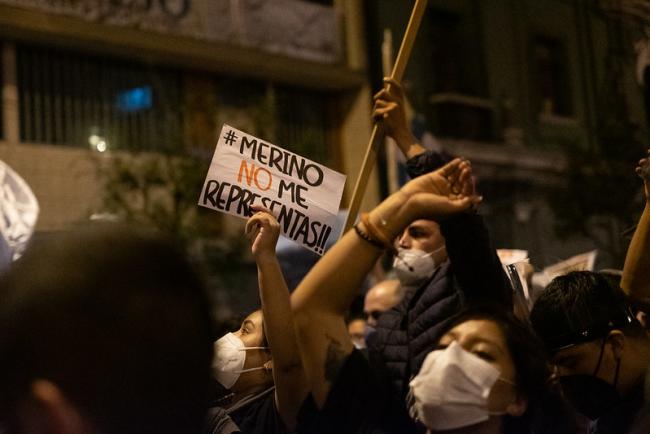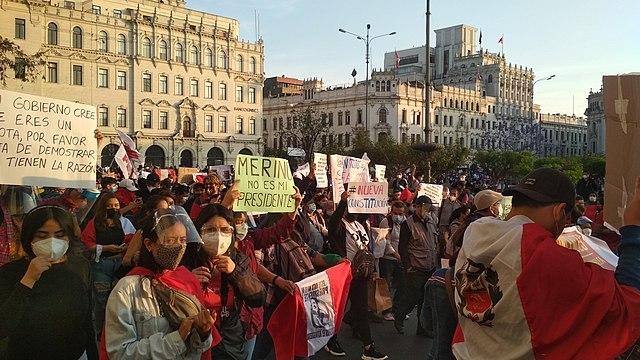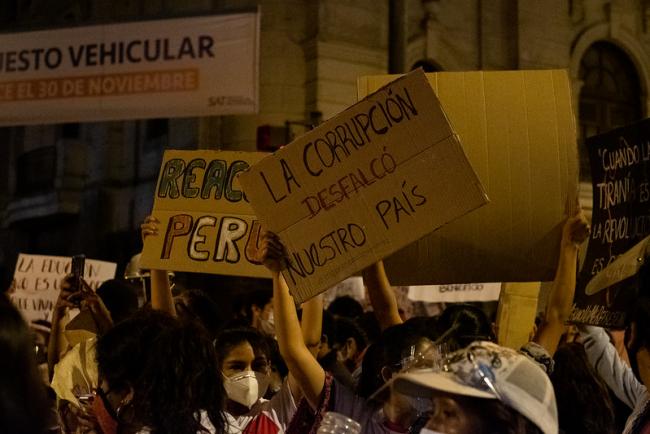
A brazen and cynical legislative coup against President Martin Vizcarra on November 9 ignited a historic week of protests in Peru. The ensuing backlash reached a breaking point five days later, when two university students—Bryan Pintado and Inti Sotelo—were killed amid a violent police crackdown which left hundreds of protesters injured, missing, or detained. The next day, interim president Manuel Merino was forced to resign, and Congress ultimately chose Francisco Sagasti, a 76-year-old industrial engineer new to public office, to replace him. Sagasti is now tasked with reconciling the fallout from the protests in order to avoid another political crisis ahead of the April 2021 general elections.
Vizcarra’s Last Stand
What was surprising about Vizcarra’s ouster—aside from the haste with which it was executed—is simply the fact that it did not happen sooner. Vizcarra, like Sagasti, was a relative outsider when he assumed office in 2018 following the resignation of his predecessor, Pedro Pablo Kuczynski. Facing an opposition-controlled Congress led by a majority bloc of right-wing Fujimorista legislators, Vizcarra quickly established a popular mandate by vowing to fight widespread corruption and impunity. This resulted in a series of clashes between the Vizcarra administration and Congress.
And up until his impeachment, the president’s odds were favorable. Legislators had failed in a similar attempt to remove Vizcarra in September. In that episode, head of Congress Manuel Merino led a rushed attempt to pass a motion declaring Vizcarra “morally incapacitated” following the release of leaked audio tapes and a somewhat bizarre scandal involving a singer with ties to the president. The effort quickly failed, with reports claiming that Merino had requested the support of the armed forces in his bid to take power. There were protests then, too, and polling suggested overwhelming popular opposition against the impeachment. The vague threat of a military coup, along with an unwillingness to deepen the political crisis, helped convince legislators to abandon the attempt.
Two months later, however, it was apparently worth another shot. Vizcarra, still the subject of an ongoing bribery investigation that had yet to provide conclusive evidence, was vulnerable. With the economy failing and the pandemic worsening, Vizcarra’s popularity dipped until a renewed effort to remove him bolstered his public support. In October, new testimony accused Vizcarra of corruption during his tenure as the governor of Moquegua.
One lingering obstacle for Vizcarra was his lack of a base of support in Congress, which is currently divided into nine legislative blocs. At the same time, establishing alliances is difficult when self-preservation, i.e. resistance to corruption reform, dictated the rules of engagement between the two sides.
It’s also important to note that the masses did not march in support of Vizcarra as had been the case throughout a series of constitutional crises, including after his decision last year to dissolve Congress and call for snap elections. Instead, Vizcarra became a point of departure as protesters reclaimed Vizcarra’s mandate and articulated it as their own desire for a reckoning of the political system. Similar to Vizcarra’s lack of party affiliation, this decentralized, inclusive movement, led primarily by youth, is untethered to a particular ideology or political party. At least initially, it aims to guarantee a transition of power to the people through the ballot.
Merino Is Not My President
After nearly three years of resisting the Vizcarra administration’s mandate to root out corruption and impunity, Congress chose to intervene at the worst possible moment: in the midst of an accelerating economic recession triggered by the Covid-19 pandemic, which has devastated Peru. With Manuel Merino next in a broken line of succession (Vizcarra did not have any vice presidents), lawmakers essentially seized the presidency. Most appear to have acted in self-interest: 68 of the 105 legislators who voted to remove Vizcarra are facing investigations.

Merino’s profile did not help either. The businessman from Tumbes was a relative unknown before September. Overall, Merino’s political trajectory involves a long history of investigations into alleged corruption and other misconduct. With protests quickly gaining momentum, Merino’s swearing-in ceremony, initially scheduled for Tuesday afternoon, was moved up—a clear indication that the window of time to claim legitimacy was fast closing.
The next day, November 11, Merino named former Minister of Defense Ántero Flores Aráoz as prime minister. A controversial figure with a reputation for far-right politics, Flores Araoz was ultimately one of several cabinet appointments that portended a far-right policy shift. Merino’s cabinet, rather than representing the plurality of Peru’s current political landscape, became a haven for an older group of politicians, including business leaders and a few officials recycled from two-time president Alan García’s administrations.
Meanwhile, it became increasingly apparent that the protests had taken on a youthful character. Demands went beyond simply calling for politicians to resign (#QueSeVayanTodos) and ensuring elections will be held in April. The potential for a new constitution, for example, has gained momentum. Similar to Chile, which adopted its constitution during the dictatorship of Augusto Pinochet, Peru’s political system is bound by the 1993 constitution, ratified through an undemocratic process in the wake of the self-coup that installed the authoritarian Fujimori regime. Sagasti, however, has publicly expressed reluctance toward holding a referendum on the matter during his nine-month tenure.
By the end of the week, a smooth transfer of power for the Merino government was out of the question as violent police repression raised concerns. The breaking point, as mentioned earlier, came on Saturday night during a second National March. The deaths of Bryan Pintado and Inti Sotelo, along with attacks on the press and numerous injured, disappeared, or detained, prompted the resignation of most of Merino’s cabinet ministers. On Sunday morning, Merino announced in a televised address his decision to step down, forcing Congress to choose a new president. A preliminary investigation will now determine whether or not Merino and his associates are culpable for the violent repression of protesters that led to numerous abuses.
La Generación del Bicentenario
The public’s fury in response to Vizcarra’s removal on November 9 was heralded by 24-year-old Carlos Ezeta’s fist when he punched a congressman in the face during a live interview. The events of following week quickly introduced Peruvians to “La generación del bicentenario,” a youthful and intersectional cohort of Gen Z and millennials who have come of age in the two decades since Peru’s transition to democracy, somewhat removed from the economic woes and internal conflict that plagued Peru in preceding decades.
As Verónica Hurtado Lozado notes, this generation’s relationship to social media played a pivotal role in disseminating information, organizing marches, exposing brutal police repression, and fostering political engagement. The name for this cohort references the country’s 200th anniversary, which will be celebrated next year. Needless to say, it will be a critical period for the nation not only to acknowledge the past two centuries, but also to contemplate its future in a way that looks beyond the current political system.

Ultimately, this generation, in a bid to recover its future, will be responsible for developing alternatives to the current neoliberal system and its modus operandi of self-interest and self-preservation. The timing could not be more critical, given the void in terms of a political vision for the country.
The call for a new constitution is emblematic of this emerging social movement and provides a framework for continued organizing toward common goals that cut across geographical isolation and ideological differences. Because it wasn’t just the elections or the integrity of Peruvian democracy that hung in the balance. Protecting a higher education reform, resisting the environmental and social harm of corporate extraction, and preserving the promise of anti-corruption reform were also part of this popular agenda. For now, there is a burgeoning interest in defining this generation, which will further integrate them into the Peruvian political imaginary. The movement has demonstrated its capacity, and activists have a desire and the means for their work to continue. What remains to be seen is how the long-term commitment of the protests will manifest.
The 2021 General Elections
It’s still early in the election cycle to know just how much the past week will shape the likely plurality of the next Congress. Much will depend on how committed the political class is to earning back a modicum of public trust and the strategies deployed by parties across the political spectrum.
For Partido Morado, the party founded in 2016 as a vehicle for the presidential ambitions of center-right technocrat Julio Guzman, the upcoming elections will provide an opportunity to continue their upward trajectory. The best case scenario for Partido Morado played out this past week after their modest legislative bloc voted in unison to reject Vizcarra’s removal—the only party in Congress to do so. Partido Morado now controls the presidency, despite occupying just nine out of 130 seats in Congress and lacking party infrastructure at the local and regional levels. Barring another embarrassing scandal or egregious acts by the Sagasti government, Guzman may end up in the Presidential Palace with a sizable legislative bloc. An alliance with the Fuerza Ciudadana party won’t hurt either.
On the other hand, center-right parties like Acción Popular and Alianza Para El Progreso may have sealed their fate to whatever extent that voters direct their frustrations at those responsible for this latest political crisis. Such was the case back in January, when Fuerza Popular lost its legislative majority and APRA, in a historic defeat, failed to receive enough votes to remain in Congress. APRA will look to make its comeback to electoral politics following the death of their party leader, former president Alan García. Fuerza Popular, in turn, faces a legal challenge that jeopardizes its participation in the April elections.
Parties on the Left, having abandoned Vizcarra last week, are no longer bound to intermittently supporting the executive as they did in the past in attempts to align with public support for Vizcarra’s anti-corruption crusade. The electoral Left, however, was not synonymous with the protests or its nascent demands, and echoing calls for a new constitution will only go so far, especially if the proposal fails to gain traction. A more radical Left would be better suited to carrying the momentum of the protests, although a more moderate approach has led to incremental gains in the past few elections.
In addition to several centrist parties with modest support, rounding out the political spectrum are fringe movements like the religious conservative FREPAP and the cult of Antauro Humala. The younger brother of former president Ollanta Humala, Antauro is the leader of a radical ultra-nationalist movement based on ethno-cacerism, a homegrown political ideology rooted in an eclectic mix of extremist views.
Ultimately, parties across the political spectrum must develop political projects that move beyond short-term alliances and petty self-interest, or else they will face obsolescence.
The Sagasti government inherits the same burden as his predecessors. Peru is still reeling from the pandemic, which has exposed the threadbare success of the past 30 years of neoliberal adjustment and compounded the end of the commodities boom that began in the early 2000s. There is also a need to address demands for either a new constitution or constitutional reforms. Corruption and impunity have been holding the country back from a more participative democracy for too long, as evidenced by the recent protests.
So far, the transition has been smooth as the country learns more about its third president in two weeks. On Wednesday night, November 18, Sagasti’s cabinet of ministers was sworn in, with several from the Vizcarra administration returning to their previous roles. As has been the case in recent years, Peru reached the brink only to settle back into an uneasy calm. A week ago, that that would have been about all you could ask for between now and the elections. But now it’s obvious the people want more.
Néstor David Pastor is a writer, musician, and translator from Queens, NY. Currently, he works with NACLA as Outreach Coordinator/Editorial Assistant and with the Latinx Project at NYU as managing editor of the digital publication Intervenxions He is also the founder of Huellas, a forthcoming bilingual magazine of long form narrative non-fiction. Follow him @ni_soy_pastor.

